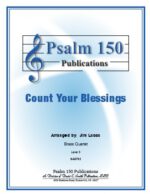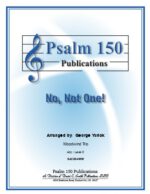-
-
-
-
Count Your Blessings
$9.95This unaccompanied saxophone quartet, AAAT, is based on a traditional hymn tune. The arrangement is from the teaching files of Monty Budahl and is useful for vesper, offertory, and special. This bright arrangement of the hymn tune has proved to be very accessible and popular as a first quartet. There is a four page score and an individual part for each player.
The arrangement is in a traditional ABA form with a bright A section contrasted by a lilting B ection with almost a feel of one beat per measure. The arrangement returns to the bright A section which builds to the climatic ending. -
Count Your Blessings
$9.95This unaccompanied clarinet quartet is based on a traditional hymn tune. The arrangement is from the teaching files of Monty Budahl and is useful for vesper, offertory, and special. This bright arrangement of the hymn tune has proved to be very accessible and popular as a first quartet. There is a four page score and an individual part for each player. The arrangement is in a traditional ABA form with a bright A section contrasted by a lilting B section with almost a feel of one beat per measure. The arrangement returns to the bright A section which builds to the climatic ending.
-
He Included Me
$4.95This clarinet solo with piano accompaniment is based on a flowing gospel song. The arrangement is from the teaching files of Monty Budahl and is useful for vesper, offertory, and special.
-
Count Your Blessings
$9.95This unaccompanied flute quartet is based on a traditional hymn tune. The arrangement is from the teaching files of Monty Budahl and is useful for vesper, offertory, and special. This bright arrangement of the hymn tune has proved to be very accessible and popular as a first quartet. There is a four page score and an individual part for each player. The arrangement is in a traditional ABA form with a bright A section contrasted by a lilting B section with almost a feel of one beat per measure. The arrangement returns to the
bright A section which builds to the climatic ending. -
Higher Ground
$11.95Rich Heffler wrote this trio so he would have a piece that would work with any 3 woodwind instruments, or hugh conglomerations of woodwinds at National Music Conferences. His ideas has been tested, and it works. In your church or school ensembles, yo
-
-
Higher Ground
$11.95Rich Heffler wrote this trio so he would have a piece that would work with any 3 woodwind instruments, or hugh conglomerations of woodwinds at National Music Conferences. His ideas has been tested, and it works. In your church or school ensembles, yo
-
Higher Ground
$11.95Rich Heffler wrote this trio so he would have a piece that would work with any 3 woodwind instruments, or hugh conglomerations of woodwinds at National Music Conferences. His ideas has been tested, and it works. In your church or school ensembles, yo
-
-
-
-
-
-
-
No, Not One!
$4.00A moderately difficult wood trio which features the scoring of a flute and two clarinets with no piano accompaniment. The clarinets begin the piece establishing the style- waltz like, and then joined by the flute as a solo. The second section is embellished by more active movement and then altered to a flute-clarinet duet. After a brief intermission of expression, the piece goes back to the earlier format and then concludes with a brief statement of the title.
-
-
-
-
Higher Ground
$9.00Vitality is the word that describes the activity of the string quartet in the whole opening section. It then moves to expressive, imitative devices in the middle section where it leads to a finale even more vigorous than the beginning.
-
Name Of Jesus Medley
$6.50An upper level violin solo with piano, the piece is very rhapsodic in nature, but is expressive throughout. As a medley, it incorporates: “The Name Of Jesus,” The Beautiful Name,” and “Take The Name Of Jesus With You.”
-
Count Your Many Blessings
$9.95Four Plus Brass Series- for two Trumpets and two Trombones (with opt. Horn and Tuba for color). Beginning with a tempo and style of vitality the introduction uses motivic repetitions until the trombones establish the tune with trumpet counterpoint. The rest of the whole first section is an exchange of thematic motives amongst the parts. With a modulation the trumpets present a little duet with the trombones adding brief flourishes. The final section again presents melodic motives passed around the various voices and then slows to a strong conclusion.
-















